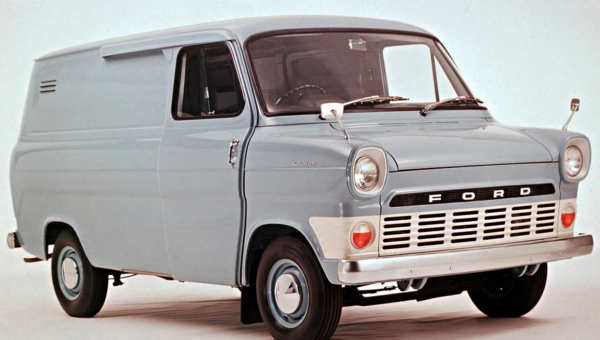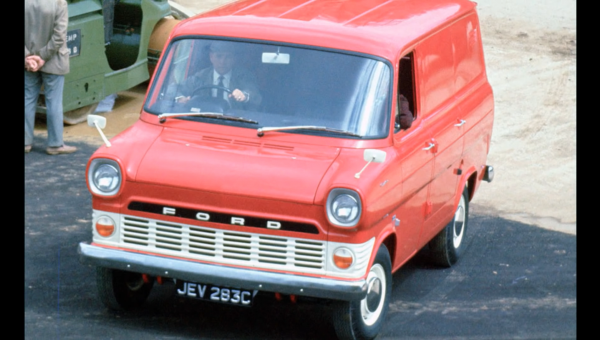Creature comforts were virtually non-existent. Instead, all you got was lashings of discomfort and bone-shaking misery. This made the process of van driving a pretty abject pursuit for all concerned.
Hmmm??… you might be thinking, as you sit there reading this article on a sumptuous sun lounger, parked up in a glorious corner of the Algarve or the wild Portuguese silver coast. You'll not just be admiring the fabulous scenery but I imagine you'll also be admiring your gleaming modern 'van-life' VW Transporter as well? There you are, soaking up the Portuguese sunshine whilst sipping a glass or three of the finest local vinho. I can easily imagine how you might be thinking to yourself - what on earth is this fellow wittering on about? Vans? Uncomfortable? Never!
Ground breaking
But Yes. I'm afraid to say that vans really were pretty unrefined affairs in days gone by. They were clattery, noisy, unwieldy things that were just generally rather ghastly. Spending any amount of time behind the wheel of a nasty old van almost represented having lost the will to live. But that all ended quite abruptly in the autumn of 1965 when Ford did something quite extraordinary. They introduced a totally ground breaking concept in the form of a genuinely drivable van. The Ford Transit MK1.
The Transit MK1 was to become an absolute game changer in the previously somewhat grim world of light commercials. All of a sudden, a lowly works van could not only look good but it could look good without compromising one single aorta of the many practicalities that were so crucial to any self respecting load lugger. In fact, these practicality aspects were actually enhanced compared to previous incarnations of light commercials. Add to these attributes the benefit of incorporating a bit of actual drivability and you can perhaps see how a van driver could enthusiastically get up in the morning and genuinely look forward to spending time behind the wheel!
The Transit arrived to replace the Ford Thames 400E. The 400E hadn't really been a great success story for Ford due to its size limitations and flat-fronted design. Sales had been consistently eclipsed by the Bedford CA which was, quite simply, a better van.
But the new Transit was very different. The design had a much wider stance than anything else on the market which gave it a far more planted look on the road. It even had a touch of cool American flare about it and that made all the difference. It actually changed the way people thought about vans in general. For the first time, a van could actually be something rather cool.
The Transit MK1's rear axle was borrowed from Ford's passenger car division as were many other key components including engines and gearboxes. The Transit's wider and longer size not only made it more planted on the road but, crucially, it also provided a lot more load space even when compared to the Bedford CA. Space was also won by moving the engine forward into the Tranny MK1's hallmark 'pig snout' engine bay. All these little design quirks and the use of actual passenger car componentry really did bring the Ford Transit into the realms of honest to goodness driveability.
This new-found light commercial driveability was a remarkable departure in the world of vans. When you consider that Ford used passenger car components in order to utilise their general parts bin (therefore cutting costs), it might be tempting to surmise that the inherent drivability of the Ford Transit had been won almost by default. Simply a happy by product of corporate bean counting? But of course, this was certainly not the case.
Ford Transit Van
Importance of design
Ford had long realised that drivers were using their vans all day long, so a design brief had been carefully formulated to focus on matters such as ergonomics. This facet of design was now just as important in the world of light commercial vehicles as it had been in Ford's line up of passenger cars. Perhaps it was even more important for van drivers in a brave new world of motorways, where they really did regularly spend whole days behind the wheels.
The demise of branch lines and the creation of modern motorway infrastructure had opened up new possibilities. Commercial interconnectivity via road networks was to become the norm. This new norm needed a new kind of van to literally deliver goods right to our doorsteps.
The Transit van had been very deliberately designed to be more car-like with reduced engine noise and heat. The new vans had been designed in a way that provided a comfortable driving position and a better in-cab environment in general. A place where drivers could better spend their working lives. Thought had been given to the cab needing easy access and exit because some drivers (such as milkmen and other delivery drivers) were constantly jumping in and out during the course of a working day. It wasn't all about clocking up huge motorway miles.
Popularity
The popularity of the Transit MK1 was clear from the offset. The Langley based factory had to operate at full capacity in order to keep up with demand. Production eventually had to be moved to a new, much larger, facility in Southampton. Consequently, the Tranny MK1 became a very familiar sight on our roads. It was very much part of the furniture throughout the 70s and much of the 80s, earning itself the illustrious title 'The Backbone of Britain'.
Countless variants from panel vans, Luton vans and pickups made the MK1 Tranny a van for all the people. Interestingly, when it came to latter day games of cops and robbers, Ford seemed to have all bases covered. It was said that the Transit's speed and agility made for a great get-away vehicle! Even the smallest variant could easily accommodate half a dozen burly villains. They may well have found themselves being chased by a Sweeney style Ford Granada and a couple of siren blasting 'jam sandwich' Ford Cortinas.
The MK1 Transit survived for over 21 years with only a few tweaks and modest styling updates along the way. Quite an achievement when you consider that the Cortina had seen no fewer than 4 models come and go within a similar time frame.
So, the MK1 Transit was a true trailblazer. It paved the way for all our stylish modern vans with their plush interiors, air conditioning and infotainment systems. So if you really are reading this whilst sitting outside your thoroughly modern campervan watching another magical sunset over Cape St Vincent or Nazaré's Praia do Norte; please raise a glass and perhaps spare a thought for one of those great automotive heroes of yesteryear. The good old Transit MK1. The van that made it all possible.
Douglas Hughes is a UK-based writer producing general interest articles ranging from travel pieces to classic motoring.



















My father had a few mk 1 transits when I was growing up. He had a 1966 minibus, then a 1967 12 seat minibus Reg : PVK593F.
Then a 1972 Transit mk1 van LLO150K
By Will from UK on 12 Mar 2022, 19:07
The english used in this article is terrible.
The Aorta is valve iin the heart I seem to remember i assume you me
meant iota ....
By david from Other on 23 Aug 2022, 12:35